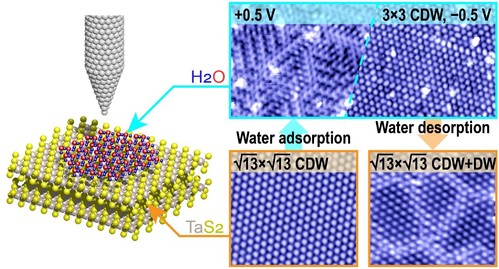Recently, Shichao Yan’s research group from School of Physical Science and Technology reported a reversible charge order transition induced by interfacial water. Their work was published in Nano Letters entitled “Single-water-dipole-layer-driven Reversible Charge Order Transition in 1T-TaS2”.
Water/solid interfaces play important roles in a broad range of research fields, including surface science, chemical physics, materials science, and bioscience. In this work, the researchers use low-temperature scanning tunneling microscopy (STM) technique to investigate the influence of interfacial water on the charge density wave (CDW) order of a prototypical 1T-structured transition metal dichalcogenides material (1T-TaS2). By carefully controlling the epitaxial growth conditions, they successfully grow highly-ordered water adlayer on 1T-TaS2. They discover that the water adlayer switches the topmost layer of 1T-TaS2 into a new and well-ordered CDW phase with completely different periodicity as that in the pristine 1T-TaS2. After water desorption, the original CDW order in 1T-TaS2 recovers, and the residual water clusters trapped by the intrinsic impurities create localized CDW domains that are separated by CDW domain walls.

Figure 1:water adlayer induced charge order transition in 1T-TaS2
First-principles calculations show that the electric dipole moments in water adlayer attract electrons to the top layer of 1T-TaS2, which shifts the phonon softening mode and induces the charge order transition. This work will stimulate further experimental and theoretical studies about investigating the interactions between interfacial water and the other collective quantum states of matter. Their results also pave the way for creating new collective quantum states of matter with molecular dipole layer.
Professor Shichao Yan and Dr. Bin Shao are the corresponding authors of this study. This work was supported by grants from the Ministry of Science and Technology of China, National Science Foundation of China, and the startup funding from ShanghaiTech University.
Link:https://pubs.acs.org/doi/full/10.1021/acs.nanolett.0c03857


